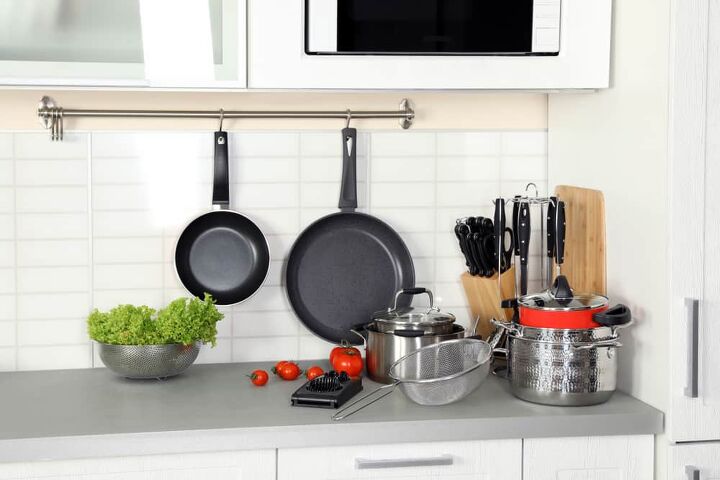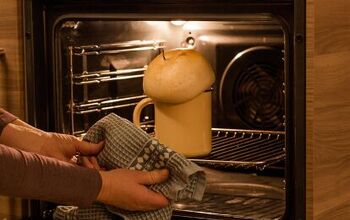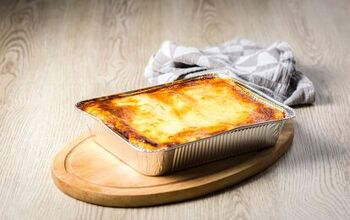Can Calphalon Go In The Oven? (Find Out Now!)

There are endless name brand cookware sets on the market today. It’s hard to know which one’s the best with so many fantastic options. Not all cookware is the same, and brands like Calphalon have quite a reputation.
You can put a Calphalon pan into the oven if the temperature does not exceed 500°F. However, you can only put a Calphalon pan with a glass cover in the oven if it is 450°F or lower. Not all Calphalon pans are broiler-safe, so avoid the broiler setting if that applies to your pan.
If you’re a big fan of Calphalon, this is your ultimate guide! We’re going to talk about what temperatures you can safely use the cookware in, precautions, and more. Let’s take a look at the details behind using Calphalon in the oven.
Are Calphalon Pans Safe for the Oven?
One of the best things about using Calphalon cookware is how versatile the products are. You can use them for a myriad of different concoctions in the kitchen. In general, a signature non-stick pan can safely be used in the oven as long as temps are 500 degrees or less.
It’s not uncommon to cover a pot or pan when putting it in the oven. If you do this, be sure that you don’t exceed 450 degrees Fahrenheit.
Safety Concerns
Unless you’re a professional chef, you might not understand the concern about putting non-stick pans in the oven. Well, you can thank a little thing called petroleum-based Teflon for that.
Petroleum-based Teflon is a type of non-stick coating that many pots and pans have. This specific type of coating can break down under extreme temperatures. When this happens, poisonous fumes are released that could cause severe health complications.
If you’re working with cookware that has petroleum-based Teflon coating, do not put it in the oven. With all that being said, this isn’t the only type of non-stick coating out there. Some companies, like Calphalon, use alternatives that are free from polytetrafluoroethylene and perfluorooctanoic acid.
It’s essential to yours and your family’s health to ensure that the pots and pans you’re using are oven-safe.
What is Hard-Anodized Aluminum?
Calphalon is usually made of hard-anodized aluminum. This type of material is made in an electrochemical process that makes aluminum much stronger. Hard anodization makes pots and pans much more durable, especially when it comes to cooking in the oven.
This is one reason why Calphalon is known for making some of the highest quality cookware on the market today. It’s important to note that this process does use chemicals, but there isn’t any leftover once the pots and pans are in the hands of customers.
Another reason you might want to opt for cookware that has hard-anodized aluminum is that they won’t get wrecked under high temperatures. They are also a lot easier to clean than other materials because of the lack of pores.
Calphalon Cookware Restrictions
Even though you can safely use Calphalon cookware in the oven, there are a few things you should be aware of. Even durable pots and pans like these come with their limitations. Let’s take a look at the restrictions that come with Calphalon products to help you avoid damaging your cookware.
You’re now well aware that you can put them in the oven at up to 450 degrees Fahrenheit, especially when using a glass lid. Something to be mindful of is the broil setting on your oven. All Calphalon pans are not broiler safe, and neither is any pan made out of enamel cast iron. If you put it in the broiler, it can permanently damage your pan and ruin the non-stick coating. The 450-degree limit is for Calphalon-specific items and might not apply to other cookware brands.
Calphalon Pan Handles
One of the most popular questions when it comes to the uses of Calphalon items is whether or not the handles are heat sensitive. Just like the pan itself, the handles will be able to handle the high temperatures within an oven. Stay-cool handles only stay safe when they’re on stovetops, not in the ovens.
This is why it’s important to know what type of plastic the handles are made out of. Phenolic handles, like the ones on Calphalon pans, are the only type that won’t get ruined from excessive heat.
You can find the temperature rating for the cookware, including the handles, from the manufacturer. No matter what material the handles are made out of, it’s crucial to wear oven mitts or use pot holders when removing something from the oven.
How to Season Calphalon Cookware
Because Calphalon products are made out of hard-anodized aluminum, many people like to season them. This is a common practice one on cast iron cookware as well. There’s an oxidation process that helps to seal the surface when the cookware is being made.
This helps to eliminate pores, but some folks like to go the extra mile. To season your Calphalon cookware, follow these easy steps!
Step One: Wash It
The first thing you need to do is thoroughly wash the cookware. You don’t want there to be any food residue. Even if you’re unpacking it right out of the box, wash it off and dry it before moving onto the second step.
Step Two: Heat It Up
Next, put the pan on your stove and put it on high heat. Add a small amount of cooking oil to the pan. Then, get a brand new sponge and spread the oil evenly around the entire surface.
Step Three: Watch For Smoke
After applying the oil everywhere, let the pan continue to heat up. Once it starts to smoke, remove it from the heat and allow it to cool. Then, after the pan is at room temperature again, you can move on to the final step.
Step Four: Wipe It Down
Take a paper towel and remove any excess oil that may be leftover. It’s important that you store your cookware correctly in an area that isn’t prone to moisture. When it comes to cleaning a seasoned pan, only use warm water.
Washing a seasoned kitchen item in the dishwasher or with soap is generally a bad idea. If you do, you’ll have to repeat the seasoning process over again.
Calphalon Cookware Maintenance
Just like other items in your kitchen, you want to treat your Calphalon pots and pans with care. There are plenty of things you can do to ensure they last a lifetime. For starters, avoid exposing the cookware to cold water immediately after it’s used.
Allow it to cool down to avoid distortion or bubbles on the coating. It’s also important that you soak the pans in warm water instead of hot soapy water. This is especially important if you’ve seasoned the cookware.
While Calphalon is scratch-proof, you might want to avoid cutting up food within the pan itself. If you do find that your Calphalon products are scratched up, it’s a sign that it’s time for a replacement.
It’s also a good idea to store them in a hanging position, rather than stacked up in a cupboard. When it comes time to clean a dirty Calphalon pot or pan, use a soft sponge or cleaning brush. Avoid harsh cleaning pads or bristles that could damage the protective coating.
Calphalon pans are dishwasher-safe, but it’s suggested to hand wash them when possible. This helps keep them shiny, as the harsh detergents can hurt the outside of the pots and pans. If you do find that they’re a bit dull, you can safely shine them using Bar Keeper’s polish.
Related Questions
How do I know if my pan is oven-safe?
In general, pans that are safe to use in the oven are usually made out of specific materials. Ceramic, cast iron, stainless steel, copper, and aluminum are all oven-safe. These can be used on the stovetop and in the oven without concern as long as you stay at or under 450 degrees.
Can Calphalon pans with rubber handles go in the oven?
Yes, they can safely go in the oven. Just be sure not to go over around 400 degrees. While Calphalon pans are safe in the oven at higher temperatures, the handles have a limit.
Does Calphalon use Teflon?
Calphalon uses a Teflon-like material that’s made with reinforcements to handle plenty of wear and tear. This is also what makes the pans oven-safe and enhances heat transfer. It’s cured at 800 degrees Fahrenheit to make it even more durable.

Kirstin is a passionate writer who loves helping people learn new things when it comes to home improvement. When she's not behind a keyboard, she enjoys DIY projects, crafts, spending time with her pets, and making videos. She hopes that with all she writes, someone is finding a solution to their home improvement needs.
More by Kirstin Harrington



























